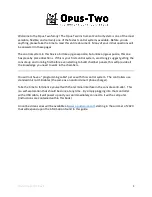
OBS501 Smart Turbidity Meter with ClearSensor
®
Technology
34
Normalized response of OBS501 to AMCO Clear
(p. 24)
, and
the datalogger readings are logged. If either reading differs by more than
5% from ones reported on the factory calibration certificate or the user’s
own calibration data, the sensor should be recalibrated. If the first two
calibration points fall within the acceptance criterion, the third value can
be tested. The recommended frequency for calibration checks is quarterly
when an OBS sensor is in regular use. Otherwise it should be performed
prior to use. Calibration checks can be done in the field.
TABLE 10-1. Troubleshooting Chart
Fault
Cause of Fault
Remedy
Fails finger-
wave test
No power, dead battery
Replace battery and reconnect
wires
Plug not fully seated
Disconnect and reinsert plug
Sensor broken
Visually inspect for cracks;
return OBS501 to
manufacturer if cracks are
found
Electronic failure. Unit
draws less than 11 mA or
more than 40 mA.
Return OBS501 to
manufacturer
Fails shake
test
Sensor leaked
Return OBS501 to
manufacturer
Fails
calibration
check
Aging of light source
causes it to become
dimmer with time
(p. 24)
)
11. References
Anderson, C.W., 2005, Turbidity (ver. 2.1): U.S. Geological Survey Techniques of
Water-Resources Investigations, book 9, chap. A6., sec. 6.7, Sept 2005, accessed
December 8, 2011, from
http://pubs.water.usgs.gov/twri9A6/
Boyd Bringhurst and Jeff Adams. “Innovative Sensor Design for Prevention of
Bio-fouling.” Oceans 2011, September 2011.
Lewis, Jack. 1996. Turbidity-controlled Suspended Sediment Sampling for
Runoff-event Load Estimation. Water Resources Research, 32(7), pp. 2299-
2310.
“U.S. Geological Survey Implements New Turbidity Data-Reporting Procedures.” U.S.
Geological Survey.
http://water.usgs.gov/owq/turbidity/TurbidityInfoSheet.pdf
















































